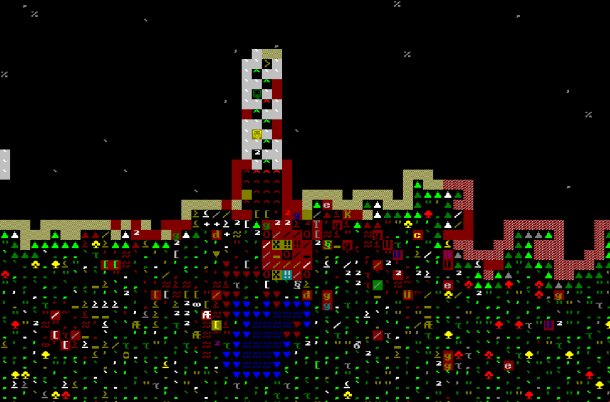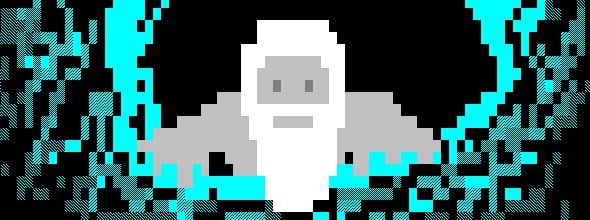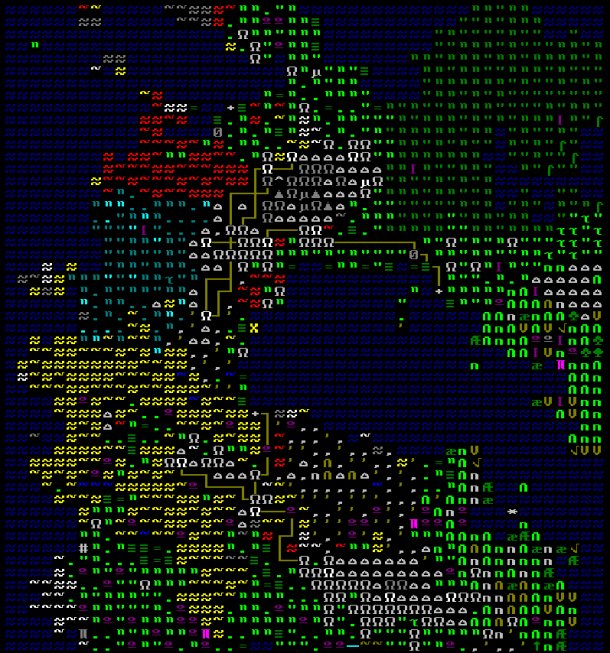Into the deep: it's time to learn how to play Dwarf Fortress

The above image may look like a cat walked all over an MS-DOS word processor. What it actually depicts, however, is unspeakable violence and brutality. A field strewn with spent arrows, severed limbs, and pools of blood leads to the trap-riddled narrow entrance of an underground fortress. Corpses of elves, goblins, trolls, humans, and even dogs rot in the open air, slain in attacks on peaceful trade caravans. The inhabitants of the fortress do not care. They got what they wanted from the wagons. Any outsiders who happened to be captured alive in the cage traps will soon be thrown screaming into the open magma pits several floors below.
This is Dwarf Fortress: an endlessly sprawling simulator of procedurally generated worlds awaiting dwarves brave enough to plunder their precious metals. Simple graphics interact with the imagination to reveal more detail than the most vivid high-polycount game—for anyone willing to learn Dwarf Fortress's notorious complexity. It's actually not as hard as you think, and 2014's Dwarf Fortress update dramatically expands Adventure mode to tell sprawling RPG adventures with the same depth as Fortress mode. It's the perfect time to learn, and we're here to help. You'll be pouring magma on goblins in no time.
We've broken this beginner's guide to Dwarf Fortress into a few digestible parts to make it easier to follow.
- Page 1: What is Dwarf Fortress? - Understand the game's Fortress and Adventure modes. Learn why you should be playing it, and how to get started.
- Page 2: What's new in Dwarf Fortress 2014? - Learn the details of 2014's major update.
- Page 3: Your First Fortress - Learn how to set up a world for the first time, understand what's happening, and where to find further resources to continue your Dwarf Fortress adventure.
- Page 4: Defeat is glorious - Learn to love losing in Dwarf Fortress, because losing is half the fun.

What is Dwarf Fortress?
Dwarf Fortress is a donation-funded free game for Windows, OSX, and Linux. It's been in development since 2002. At this point, it's likely the most complex video game ever created, though its designers, Tarn and Zach Adams, still consider it an alpha. Tarn has called the game his life's work .
If you've seen pictures of Dwarf Fortress, you're probably familiar with Fortress mode, where the player acts as the overmind of upwards of hundreds of dwarves, each fulfilling their own AI directives. The latest version brings subtle improvements to this mode, in dwarven emotions and increased connections to the outside world.
There's also Adventure mode, which allows you to take control of a single dwarf—or a human, or an elf, or any species you care to mod in—to go romping about in a massively complex simulated world full of tragedy, gore, and glory. The newly revamped conversation system allows you to collect foolhardy allies and track down wicked necromancers for fame and honor. Imagine a Dungeons & Dragons campaign plopped into an immensely complex simulation engine, and you'll have an inkling of DF's Adventure mode.
| Adventure Mode | Fortress Mode |
|---|---|
|
|
Dwarf Fortress is two games in one. In the newest release, the two modes interact more than ever before. It is now possible to stop playing a fort without destroying it, allowing you to build a new one in the same world while the old one flourishes under the care of the AI.
The biggest gaming news, reviews and hardware deals
Keep up to date with the most important stories and the best deals, as picked by the PC Gamer team.
You can also switch to Adventure Mode from Fortress mode and explore your handiwork; consider it building your RPG world before playing in it. Whether you adventure in peace or leave the denizens in pieces is up to you. Be warned, though: you may arrive only to discover that a fell and terrible beast has beaten you to the idea.
There's no way around the fact that Dwarf Fortress is not a casual game. Its influence can be felt throughout newer games that are easier to pick up, from Minecraft to Rimworld , but none have yet offered the same depth and complexity of simulation. The one thing that everyone knows about Dwarf Fortress, however, is the text. Screenfulls of it, in sixteen colors, blood-soaked punctuation marks scattered everywhere like a fatal explosion at the typewriter factory. The aesthetic is a close cousin of pixel art, born from similar limitations. If the cascade of colored letters is intimidating, don't panic. After a few minutes of direct exposure, the bafflement wears off and you begin to see the pattern. If you're still not convinced, the community maintains sprite graphics packs which bring more of a 16-bit JRPG look to the game, within some engine limitations. (For example, the male symbol may display as a bag even when it does mean a literal male symbol; apostrophes may look like patches of ground even mid-sentence.)

There's one big upside to these simple graphics, of course: you don't need a fancy high-end GPU to play. What you do need is a lot of CPU power. Dwarf Fortress puts the hurt in gigahertz. Don't generate large worlds with long histories unless you're looking for an excuse to pick up a new novel.
On page two: the major changes in DF 2014.
Melissa is an author and information security researcher with a special interest in video game glitches and speedrunning. She has been playing Dwarf Fortress for years, is pro-dwarf, and vehemently anti-elf.

